Local SEO is definitely not new in 2024 but it does continue to grow in importance–if that even seemed possible. Nearly a third of people search for a local business online every day, and almost 50% of all searches on Google are for local information.
To help you attract these local searchers, I’ve put together this handy 13-point local SEO checklist featuring the top areas you can optimize around to get found by local customers in your area, and I’m sharing some actionable tips and examples to help you get started.

Table of contents
Keep reading, or skip to the checklist item you want to learn more about below:
Why is local SEO important in 2024?
Before we get into our local SEO checklist, you might be wondering why local SEO is even that important. Just look at these local SEO statistics:
- Local and organic traffic makes up nearly 70% of all traffic to websites.
- Nearly 80% of smartphone searches for local businesses lead to an offline purchase.
- Local searches lead to purchases 28% of the time.
These stats show that if don’t have a strong local SEO strategy in 2024, you’re missing out on potential customers looking for businesses like yours.
Local SEO checklist for 2024
By checking off the items in this local SEO checklist, you can increase your chances of getting found for relevant local searches while driving more (potential) local customers to your website.
1-4. Create a solid foundation with your website
You can’t have good local SEO without a solid foundation to build on. And your website is the most important component—without a great website that adheres to SEO best practices and avoids common SEO issues, no amount of optimization is going to get you the results you want.
Make sure your website includes the following:
- Mobile-friendly or responsive design. Google now indexes the mobile version of your website over your desktop version, so this is a must for local SEO.
- Fast page speed. Page speed is an important ranking factor—plus, searchers will leave a website if it doesn’t load quickly.
- The right URL structure. The way your website is structured matters to both searchers and search engines. Make sure you have an easy-to-navigate site with a clear path for users to take from the moment they land on your site until they become a lead. (You should also submit your sitemap to Google to help with this!)
- Internal links. Linking relevant pages of your site together can help Google and searchers find information on your site.
🛑 Try our website grader to find out where your website is winning and identify any potential areas for improvement.
5. Use structured data
Structured data is a standardized format of code that you add to the backend of your website to provide information that can help Google and other search engines decipher your content and what your page is about. This is often referred to as Schema markup.
You can add Local Business structured data to give Google information about your hours of operation, what your business offers, your reviews, and more to help you show up better for relevant local searches.
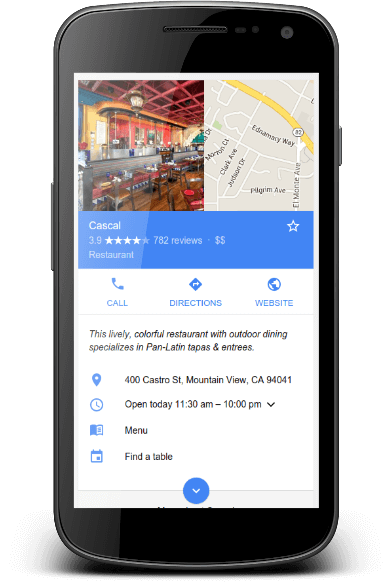
An example of a listing showing from using Local Business structured data.
6. Identify and incorporate local keywords
Speaking of local searches, it’s important to know the types of local searches you want your business to rank for in searches. The best way to do that? Conduct local keyword research to build your keyword list.
Keywords are the words or phrases that people use to find information on search engines. By targeting specific keywords as part of your local SEO strategy, you can increase your chances of appearing for those searches.
You want your SEO keywords to be related to your business, your products or services, and your location so you can target searchers in your area.
Here are some examples of good local keywords for a plumber:
- Best plumber Dallas
- Dallas plumbing
- Plumbing company Dallas

Examples of local keywords from WordStream’s Free Keyword Research Tool.
You should also identify some long-tail keywords, which are longer and more specific phrases customers are using to find businesses like yours. You can use these phrases to create valuable content that will drive more traffic to your website from search engines.
Here are some examples of long-tail keywords for a plumber:
- How to fix a clogged drain
- What to do if my toilet is leaking
- How do I keep my faucet from dripping
Your keywords should be included in your title tags, meta descriptions, and on-page content for your website. They can (and should) also be used in your Google Business Profile and social media profiles, which we’ll talk more about later.
💡 You should also include local keywords in your business description. Find out how to write the perfect business description in our free guide!
7. Optimize title tags and meta descriptions
Once you know that your website is in good shape and you have a strong local keyword list, you can start optimizing for local searches. One important way to do this is by optimizing the title tags and meta descriptions for each of your web pages.
Title tags are the HTML code that shows the title of the page—this is also what shows up in search results.

Your title tags should be between 50-60 characters long and include your target keyword and potentially your location (depending on the page).
Meta descriptions are the HTML code that shows under the title of a page in search results to give users a better idea of what content to expect on the page before they click.
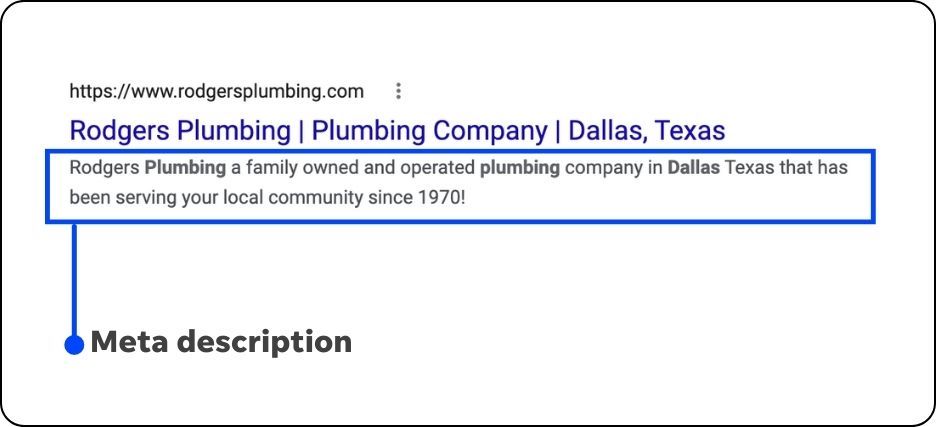
Your meta descriptions should be between 50-160 characters long and include your target keyword and a description of the content on the page. Google Bard is a good, free tool that’ll help you write these snippets.
8. Consider a blog (or an FAQ page)
Experience, expertise, authoritativeness, and trustworthiness (also known as EEAT) are four key ranking factors Google looks at to determine whether or not the content on a website will be useful for a searcher.
Creating regular content in the form of a blog can help you exponentially in these areas. A blog gives your business a place to showcase your expertise and authority while keeping your website consistently updated with fresh, keyword-rich content. And if you’re writing about topics that you have first-hand knowledge of, then it boosts that experience factor.

Plus, you can use the content you’re creating for your website throughout your marketing. For example, you can share links to your posts on your social media sites, feature your blog posts in a regular newsletter, and create more in-depth downloadable content to capture web visitors’ information like their email addresses and phone numbers.
If you already have a blog for your business, make sure you’re creating content that is keyword-focused (this is where that long-tail keyword research comes in handy!). If you don’t already have a blog for your business and you want to start one, you can do keyword research, use tools like Google Trends to find out what people are searching, and even ask your customers what they might want to see from you. (You can also check out this guide for how to start a business blog!)
If you don’t think you have the time or resources to maintain a business blog (it does take time and planning), you can still create helpful keyword-rich content in the form of an FAQ page. An FAQ page can provide answers to commonly searched long-tail local keywords while also giving search engines and searchers valuable information that can help you rank or win business.
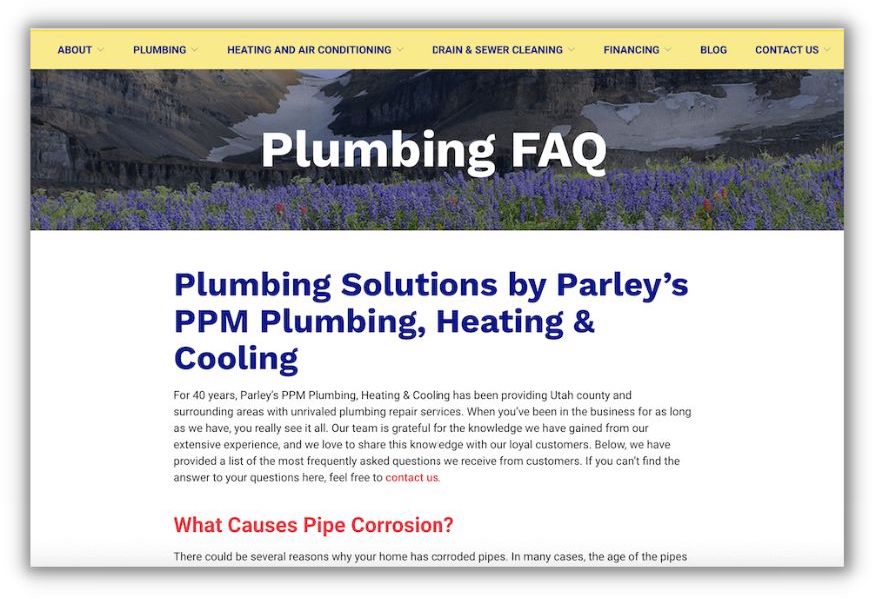
This business created an FAQ that addresses common plumbing questions.
9. Claim and optimize your Google Business Profile
Your Google Business Profile can help you get found in local searches happening directly on Google Search and in Google Maps. Google Business Profiles contain a ton of information that can help customers take action (like calling your business or getting directions!) right from your profile. Plus, they’re typically the first batch of results that show below ads for any local search.
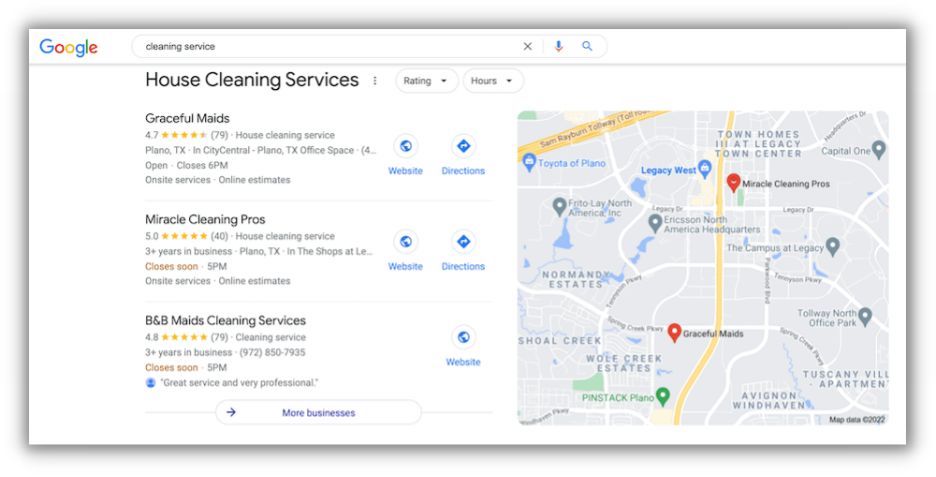
The first step here is to make sure you claim your Google Business Profile. You can now do this directly from Google Search! Simply:
- Search for your business on Google
- Click on the result for your business and click “Own this business?”
- Then follow the prompts to claim the page
If your business isn’t already listed on Google, you can add it:
- Go to business.google.com
- Click “Manage now”
- Click “Add your business to Google”
- Then follow the prompts to add your business
Make sure that you verify your Google Business Profile after claiming or adding it so you can make changes to the page as needed.
Once your listing is claimed, you can take steps to optimize it. Multiple components of your Google Business Profile can give your local SEO a boost, so this is an important step.
Here are some crucial ways to optimize your Google Business Profile for local SEO:
- Make sure all information is accurate. Your hours of operation, business website, business phone number, and address must be correct (and consistent with other listings—which we’ll talk about more later.)
- Fill out all the sections. It’s best to add as much information as possible to your Google Business Profile so you can present the best picture of your business to prospective customers.
- Add the right business categories. Many SEO experts believe the primary category you choose has the most impact on your local search rankings, so choose wisely! (You can also change it later if needed.)
- Upload relevant pictures. Google allows you to add several pictures and suggests including your logo, a cover photo, the interior and exterior of your building, your team, and action shots of your team at work.
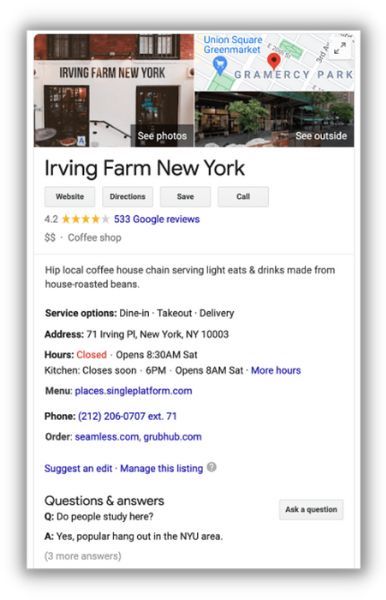
10. Manage reviews (and get more!)
Reviews are another important local ranking factor that your business can’t (and shouldn’t) ignore. Nearly 90% of people read reviews for local businesses—and search engines want to give the people what they want. Which is clearly: Reviews.
Google looks at your reviews, including how many reviews you have, when determining your rank for specific searches. Certain keywords or phrases within your reviews can also help (or hurt) your performance in local search results.
And, having a higher star rating can also help you in local search—when a person conducts a search containing “best,” Google will only source businesses with a 4.0-star rating or higher.
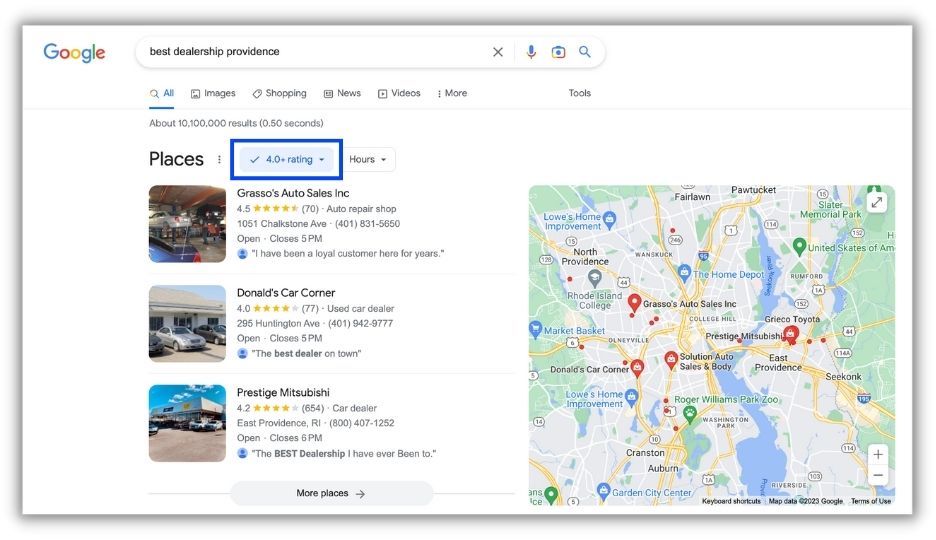
All this to say that it’s extremely important to make sure you’re getting good reviews!
You can get Google reviews by:
- Asking your happy customers to leave you feedback
- Including a link to your Google Business Profile on your website
- Including a link to your Google Business Profile in customer emails (We have some review request email templates you can use for this!)
- Sending an email survey
Once you have reviews, the work doesn’t stop. It’s also important to respond to reviews. Google lists “Manage & respond to reviews” as a way to improve your local ranking on Google.
11. Keep your local listings consistent
Local listings are a huge component of local SEO. Listings show up in local search results and can help your business get discovered on specific maps, apps, or sites (as well as search engines), so it’s important to have your business listed on the top local listings sites.
But it’s even more important that your business information across all those sites is consistent. Search engines want to make sure they’re showing searchers the most accurate and useful information. They do this by using signals from across the web—if they see that all the crucial information about your business (specifically your Name, Address, and Phone Number—AKA NAP) is consistent, then they have a high level of trust that they’re showing the correct information.
However, if they find conflicting information or inconsistencies, they have a lower level of trust and may not show information about your business on the first page of search results (or at all 😱).
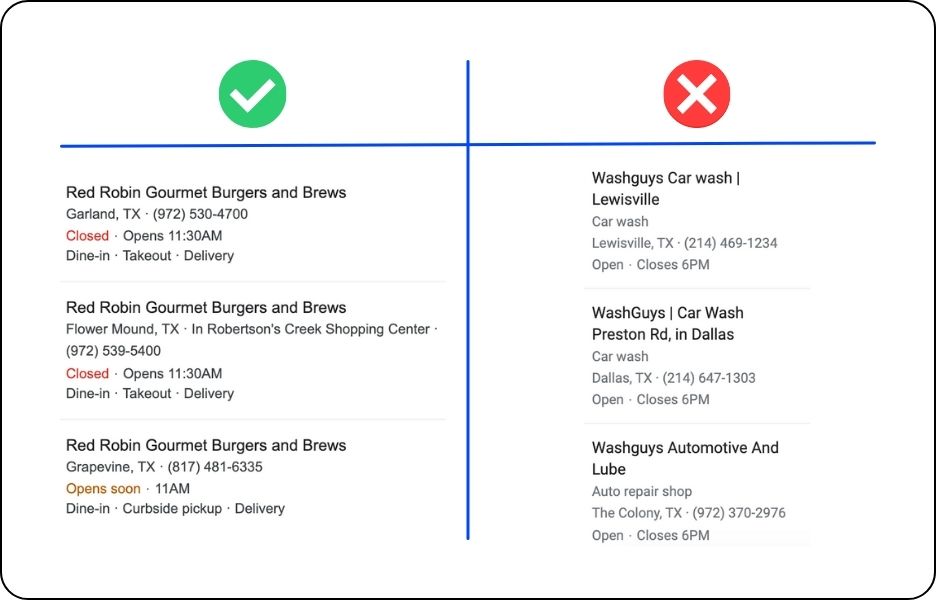
An example of consistent vs. inconsistent Google Business Profile listings.
This is why it’s important to add local listings consistency to your local SEO checklist. You want your business name, address, and phone number listed the EXACT same across every directory—including Google Business, Yelp, CitySearch, and more.
Also: Adding local keywords to your listings is another great way to boost local SEO through your local citations. You can do this in your business description, the About field of your listings, or any other opportunity to organically include them.
🚨 Are your listings helping your business (or hurting it)? Find out with our free business listings grader!
12. Build local backlinks
Link building remains an important SEO tactic. And local link building can boost your business’s SEO by sending signals to search engines that other local sites find your website authoritative and trustworthy.
Here are some ways to build local backlinks:
- Manage local listings. We already touched on the importance of local listings, but these provide built-in backlinks to your site.
- Guest posting. Guest posting allows you to build your business’s credibility by sharing useful posts on other websites/blogs to reach your target audience. Many websites accept guest posts with links to your brand website and brand mentions. Aim to get your posts published on authoritative websites in your niche and neighborhood.
- Sponsor local events. Aside from being a great way to support your local community, sponsoring events brings publicity to your business, guarantees valuable links to your website on the event page, and can earn your business media mentions. All of these boost traffic. To sponsor local events, start small and don’t limit your idea of sponsorship to funding. You can sponsor events by donating snacks to attendees (if you run a catering service)—don’t be afraid to think outside of the box!
- Get on local digital news sites. Don’t underestimate local newspapers. Write press releases to be published on local news sites or talk to reporters and supply them with stories relating to your business. You can even become a columnist in local media and publish regular commentary on brand-related topics.

This article from the IndyStar highlights a new restaurant opening in the area.
13. Use social media
It may not seem intuitive to include social media marketing as part of your local SEO checklist, but hear me out. It can actually benefit your business’s SEO in a few different ways.
For one, social media sites like Facebook and Instagram give you opportunities to include your business address—which can act almost like their own little listing sites.
Plus, social media sites routinely show up in local search results for your business name, so by managing profiles across social media sites like Facebook, Instagram, X (formerly Twitter), and LinkedIn, you can give your business more real estate on search results pages when a person searches for your business.

After the website, the top results for WordStream include its X, LinkedIn, and Facebook pages (complete with full tweets from X).
It’s also important to remember that while search engines are still the primary place that people are searching for businesses, they’re increasingly open to finding new businesses through social media. So by investing in a social media marketing strategy, you can increase your chances of getting found in multiple channels by potential customers.
Check all the boxes for your local SEO checklist
Local SEO is a valuable addition to your marketing plan and is one of the best ways to drive more traffic to your website and get in front of local searchers to generate leads.
Here’s your 2024 local SEO checklist:
- Have a mobile-friendly or responsive website
- Test your site speed
- Use SEO-friendly URLs
- Create internal links with locally relevant anchor text
- Add structured data
- Identify and incorporate local keywords into your web content
- Optimize title tags and meta descriptions
- Write keyword-rich blog content (or FAQs)
- Claim and optimize your Google Business Profile
- Manage reviews (and get more!)
- Keep your local listings consistent
- Build local backlinks
- Use social media






